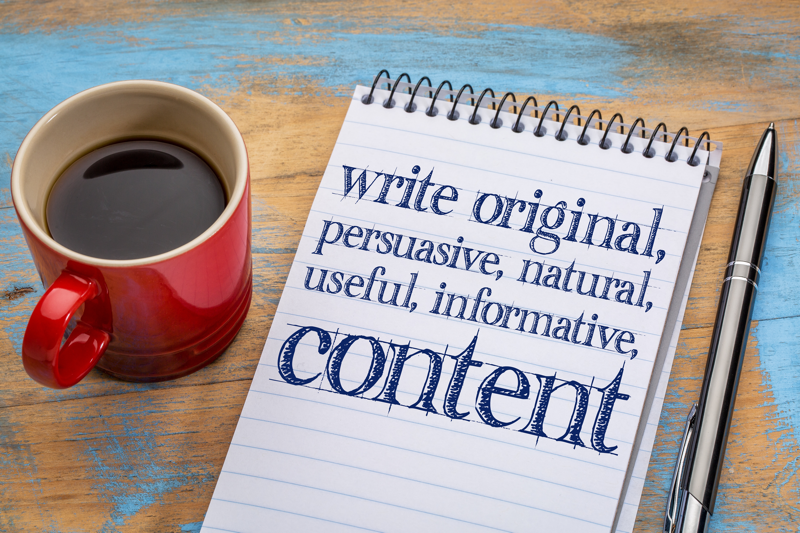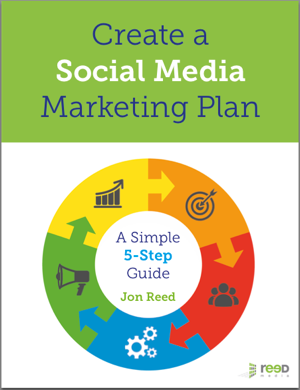There are lots of types of content on the internet: blog posts, podcasts, videos, email newsletters. Web content can be text, images, video or audio. In this post, I look at four types of text content your website needs in order to work for you.
4 types of web content – at a glance
The four types of web content each require a slightly different style of writing, and have a different goal:
- Essential pages. Your basic content such as About, Services and Contact. The minimum viable content to say you have a website! These pages need to be clear, simple, direct – and short.
- Policies and statements – such as Privacy Policy, Cookie Policy, Accessibility Statement and GDPR Statement. Needed for compliance. They should be as straightforward and understandable as possible, while including any legal wording may be required. They may be quite long.
- Sales pages. May be called product pages or landing pages. This writing must be clear, simple, focused – and as usable as possible. It should guide the reader to a specific call to action, such as ‘buy now’.
- Engaging content. This includes articles and blog posts. The goal is readable, engaging, interesting content that is useful to your target audience. It might solve a problem or answer a question.
Let’s take a more detailed look at each type of web content.
1. Essential pages
We’re talking about the basics here. Your essential web pages such as About, Services and Contact. The minimum viable content to say you have a website! These pages don’t need to be fancy or over-written. They need to be clear, simple, direct – and short. Your Contact page may just be a form. And your About page may have plenty of internal links to more detail about what you do. But such pages are the essential infrastructure of your website. They allow people to perform basic functions – such as contact you or find out what you offer and if it matches what they’re looking for. Keep them updated as necessary – but these are pages you won’t necessarily keep coming back to.
2. Policies and statements
These include any statutory requirements your website needs, such as Privacy Policy, Cookie Policy, Accessibility Statement and GDPR Statement. They may also include Terms and Conditions, Terms of Use, and any such pages specific to your product, service or sector.
These pages aren’t meant to be a cracking read or provide entertaining, interesting content: they’re needed for compliance. That said, they should be as straightforward and understandable as possible, and written in plain language. Yet, at the same time, you will need to include any legal wording required. And legalese is never that much fun to read. They may also be quite long, since you need to cover everything necessary.
3. Sales pages
Sales pages – or product pages, service pages or landing pages – are composed of selling copy. This writing must be clear, simple, focused – and as usable as possible. It’s sometimes described as ‘UX writing’ (i.e. user experience) – which is also something that applies to product instructions and documentation, and to the design, wording and ordering of navigation menus. But simplicity, clarity and usability are key here.
Your sales pages should be persuasive, and guide the reader to a specific call to action, such as ‘buy now’. But they should also do this with the minimum text necessary to communicate clearly.
Don’t say: You must log in as a member before you can watch this video.
Do say: Join now to view.
4. Engaging content
This is where things get creative – and it pays to be (or hire) a professional writer. People’s web content expectations are higher that they used to be – now we’re all used to reading online versions of newspapers and magazines, written by proper journalists.
Use journalistic principles to write and structure your articles and blog posts. Start with the most important information first, then get more detailed. But, above all, this content should be useful, informative, engaging, even entertaining, to your target audience. It might solve a problem for them, answer a question, or help them research a topic.
It pays to think about who you want to attract onto your website. Think marketing ‘personas’. What are they interested in, what problem do they want solved – and how can you help them? That will guide your choice of topics, and help you keep your content relevant and interesting. Even if it is to a niche audience!
Your content should be clear, readable and well-structured. Break it up with subheadings, bullet points and images. You also need to think about Search Engine Optimization (SEO) principles, so that your target audience is more likely to find you via Google. Think about the keyword or phrase you want to target for each blog post – i.e. what people will type into Google to find you. Use it in your text, title and headings – but in a natural, unforced way.
These posts should be informative and useful on their own – even if they don’t result in sales or signups. Your reader should always take away something useful from your content, which helps them in their professional or personal life. But be sure to use a ‘call to action’ at the end of every blog post, to encourage your reader to do something. This might be to buy something or sign up to your newsletter. Or it could simply be an invitation to comment on your post.
If you are selling something, be sure to link to your sales page(s) in your blog posts. Not just in your call to action, but in the text itself, if it’s contextually relevant. Ideally, your sales page links will be from keywords in your text.
When should you use each type of web content?
You’ll need all four types of web content when starting a new website. But there are times when you need to focus on just one. Here are some scenarios:
- Starting a new website. You’ll need all four, but will probably tackle them in the order or priority set out here. Once you’ve got your essential content, policies and at least one sales page, then you need to focus on your engaging content. This is what will get people onto your site – which is less of a priority if you don’t have anything to sell yet.
- Refreshing or migrating your website. Focus your efforts on engaging content. You’ll already have your essential pages, it’s possible you’ll want to update your policies and statements, but your sales pages will be the same, unless your offer is changing. I have some recent experience of this. Both this Reed Media site and my Publishing Talk site used to be on .eu domains (since lost to Brexit…) So I’ve migrated and re-built both. The bigger job was the 14-year-old content-rich Publishing Talk website. But such migrations are also an opportunity to refresh (or retire) old, dated content that isn’t working for you, refocus your content for your current audience, and update anything that’s no longer current.
- Not getting enough traffic. This can happen with a new site, or a relaunched site. Focus on new engaging content. Be rigorous about writing for SEO. Post more regularly. Update and republish old posts.
- Traffic has dropped. If your traffic has been good in the past but has now dropped, in addition to posting new, regular content, try updating your older engaging content. Don’t underestimate the value of refreshing content – especially if your website has been around for years. For example, I spent some time in 2020 updating blog posts and articles for a horticultural business. It’s a very established business with a lot of web content – but some of the older posts were dated or rather thin. They were no longer providing the useful, interesting, engaging, valuable content customers expected and were looking for. So this was a mix of re-writing old posts and writing new ones, so that they would turn up in relevant search results. Once people were on these new pages, they were guided to links to relevant product pages.
- Not selling enough. You’re getting good traffic – but no one’s buying. You’re not getting the conversions. Look at the links between your engaging content and your sales pages. Are your blog posts targeting the right keywords that match your offer and your sales pages? Are you linking to the right, relevant sales pages? Ideally with those keywords? And are your sales pages clear and simple enough, with an obvious call to action, such as call us, buy now, book an appointment or sign up?
Think of your reader first
It’s a lot to juggle – engaging, readable, original, natural, useful, informative, well-structured content – that’s also SEO-friendly, persuasive and works with your sales objectives. But think first about your reader, and what they will value.
Imagine you’re writing for just one person – either a real person or one of your marketing personas. Keep it friendly and natural, and don’t try to force it. You’ll build a reputation for a useful source of content for your target audience, and the sales will follow.
Need some help with your web content?
You don’t have to do all this yourself, of course. If you need some help with your web content – either for a one-off blog post or a longer term project – get in touch.

